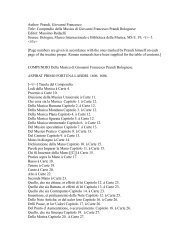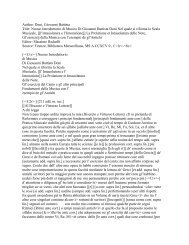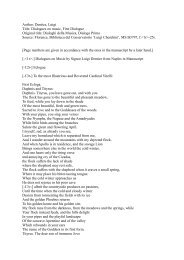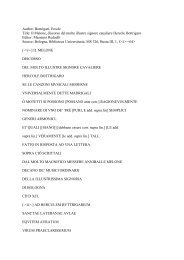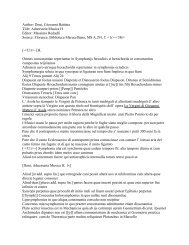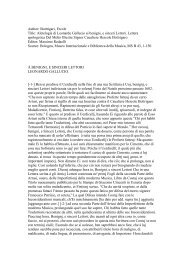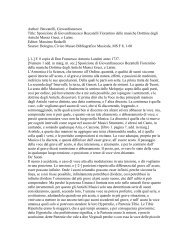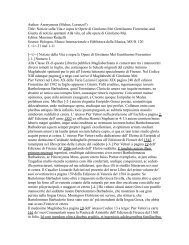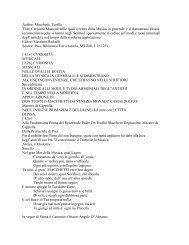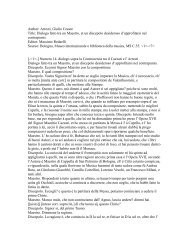Author: Doni, Giovanni Battista - manuscripts of italian music theory ...
Author: Doni, Giovanni Battista - manuscripts of italian music theory ...
Author: Doni, Giovanni Battista - manuscripts of italian music theory ...
Create successful ePaper yourself
Turn your PDF publications into a flip-book with our unique Google optimized e-Paper software.
that the thick one is the one in which all the consonances are divided and separated by<br />
intervals more frequent and abundant. For instance the Chromatic, where one<br />
proceeds by larger and minor semitone, which are intervals more numerous than the<br />
tones with the Diatessaron, is divided into siex intervals and seven notes in the perfect<br />
instrument, or five intervals and six notes in the participated instrument. He says then<br />
that the Trihemiditone or minor third is not an interval <strong>of</strong> this genus because it is a<br />
real consonance, and the consonances are not intervals <strong>of</strong> any genus, namely, they<br />
must not be laid out as [specific and add. supra lin.] uncompounded in any genus. [[In<br />
fact, if anyone] The name <strong>of</strong> the Diatessaron, which means '[[through]] <strong>of</strong> four',<br />
namely 'a consonance which is the result <strong>of</strong> four sounds' does not create any nuisance,<br />
as he says, because this has to be understood only with regard to the diatonic. Then,<br />
he adds that the Enharmonic genus is very think because it progresses by smaller<br />
Semitones and dieses which are the smallest among all the intervals and closest<br />
together ad that the Ditone cannot be an interval <strong>of</strong> this genus (albeit all the ancient [-<br />
-] and modern writers say so) because it is a true and perfect consonance which<br />
has to be filled (namely, divided into other intervals) like all the others. [[For this<br />
reason]] [Therefore corr. supra lin.] the diatessaron (in this genus) will have eight<br />
intervals and ten Tones, because, if the Ditone and semiditone have to be placed<br />
uncompounded in this two genera, they would be less thick than the Diatonic, because<br />
all the dissonances are more sparse than the tones. Consequently, he holds that only<br />
the Diatonic has to be considered in the division <strong>of</strong> the Diatessaron and that for the<br />
Chromatic it is enough that one should divide the larger tone and for the Enharmonic<br />
the larger semitone with admirable artifice and correspondence <strong>of</strong> the Harmonic<br />
Reason, because it seems that the diatessaron is the interval that demonstrates and<br />
constitutes the Diatonic, since it is the amount by which the Diapason exceeds the<br />
Diapente. [[The tone]] and thus the [[ton]] tone specifies the Chromatic because it is<br />
the amount by which the Diapente exceeds the Diatessaron. Equally, is seems that the<br />
Semitone [[puts to]] demonstrates the Enharmonic because it is the excess or the<br />
difference between the Diatessaron and the Ditone. Moreover, he wants these three<br />
genera to be like the Good, the Better one and the best one, and, consequently, that the<br />
second one cannot [[be]] stand without the first one nor the third one without the<br />
second, while the chromatic is nothing but a thickened Diatonic, and, equally, the<br />
Enharmonic cannot exist by itself but that, once it is added to the other two, it<br />
constitutes a very thick and most perfect genus, which is not called Diatonic or<br />
Chromatic any more, [--] but Enharmonic. He also says that nobody ever thing<br />
that the chromatic and Enharmonic have been separated from the Diatonic, or that in<br />
[[any]] [one corr. supra lin.] <strong>of</strong> them it is possible to make any song, because one<br />
cannot proceed continuously through Chromatic and Enharmonic intervals, as he<br />
maintains to have demonstrated on the basis <strong>of</strong> Ptolemy's account <strong>of</strong> Ptolemy and <strong>of</strong><br />
the sense <strong>of</strong> hearing, and how he will demonstrate [, albeit differently, add. supra lin.]<br />
further one when he will deal with practice. But he did not do so because he was<br />
prevented to do so by death.<br />
[--] One presents the Enharmonic system <strong>of</strong> modern theorists [[divided into]],<br />
namely divided into the three genera. [[the opinion <strong>of</strong> modern theorists on the<br />
closeness <strong>of</strong> the intervals in the two genera is refuted]] chapter<br />
This is what Salinas [have ante corr.] has written Salinas and almost all the other<br />
modern writers on the division <strong>of</strong> the Chromatic and Enharmonic <strong>of</strong> which they have<br />
put the examples in the system <strong>of</strong> an octave harmonically divided in a single line, with



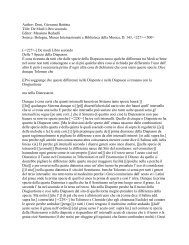
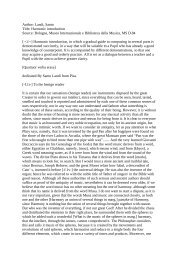
![Doni, Giovanni Battista Title: Trattato Dei Tuoni o [[Harmonie de]]](https://img.yumpu.com/45461005/1/190x245/doni-giovanni-battista-title-trattato-dei-tuoni-o-harmonie-de.jpg?quality=85)
